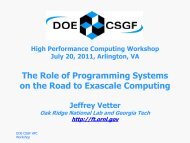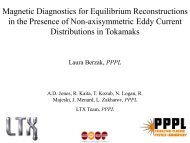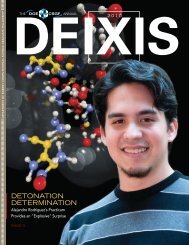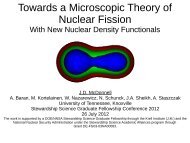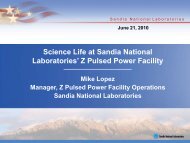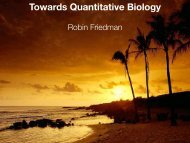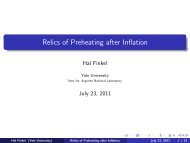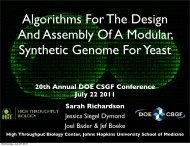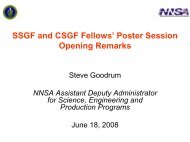2012 - Krell Institute
2012 - Krell Institute
2012 - Krell Institute
Create successful ePaper yourself
Turn your PDF publications into a flip-book with our unique Google optimized e-Paper software.
E GLOBE<br />
ckey Pucks<br />
focus computation on the most interesting areas, like where<br />
instabilities occur.<br />
VALHALLA, one of Hittinger’s latest ICF projects, combines<br />
AMR with an efficient algorithm for solving the Vlasov-Poisson<br />
equations, which describe the self-consistent evolution of plasma<br />
particle distributions. The goal: cut the computational cost of<br />
simulations in phase space – up to three spatial and three velocity<br />
dimensions – to make such simulations practical. “We haven’t<br />
demonstrated yet that it’s absolutely going to give you a speedup”<br />
in computation, Hittinger says, but work is continuing.<br />
Hittinger’s ICF work led him to magnetic confinement fusion,<br />
which trades a tiny pellet for a giant plasma cloud, hotter than the<br />
sun, swirling through a donut-shaped chamber called a tokamak.<br />
In the core, a magnetic field confines the plasma while radio waves<br />
heat it enough to strip away electrons and fuse hydrogen nuclei.<br />
Hittinger works on kinetic models for the plasma edge – where the<br />
magnetic field doesn’t confine the plasma – which varies significantly.<br />
To be most efficient, the models’ computational grids should<br />
follow the magnetic field lines, Hittinger says. “Of course, the<br />
magnetic field is not a simple structure, especially in a tokamak<br />
and certainly not in an edge geometry.”<br />
Nonetheless, COGENT, the code Hittinger is developing with<br />
researchers from LLNL and Lawrence Berkeley National Laboratory<br />
– including fellow DOE CSGF alumnus Daniel Martin – already has<br />
shown good agreement with some theoretical benchmarks. It uses<br />
high-order methods on mapped grids to solve the gyrokinetic<br />
Vlasov-Poisson equations, a plasma model suitable for an imposed<br />
magnetic field.<br />
VALHALLA and COGENT are just two of the many “pucks” that<br />
have Hittinger’s attention. He’s also helped plan for the Fusion<br />
Simulation Program, a proposed multiyear, multi-institutional effort<br />
to develop a predictive, whole-device tokamak model. The project<br />
These visualizations show Vlasov-Poisson simulation results for a<br />
bump-on-tail instability problem, where a non-equilibrium distribution<br />
of electrons drives an electrostatic wave. The left image shows particle<br />
density as a function of space and velocity. The right image shows the<br />
adaptive mesh refinement computational grid that calculates conditions<br />
with greater resolution around the resonant particle trapping region<br />
and with less resolution elsewhere, conserving computer resources.<br />
would couple codes portraying different physical properties, much<br />
as climate researchers join components into community models.<br />
It’s a full plate for someone who didn’t picture himself at a<br />
national laboratory when he started graduate school. “If it weren’t<br />
for the CSGF, I probably wouldn’t have come to the lab,” Hittinger<br />
says. “I’m glad I did, because it fits my personality and my skill set.<br />
We do interdisciplinary things, and they’re hard problems. I don’t<br />
think there are many opportunities for that.”<br />
DEIXIS 12 DOE CSGF ANNUAL P21



